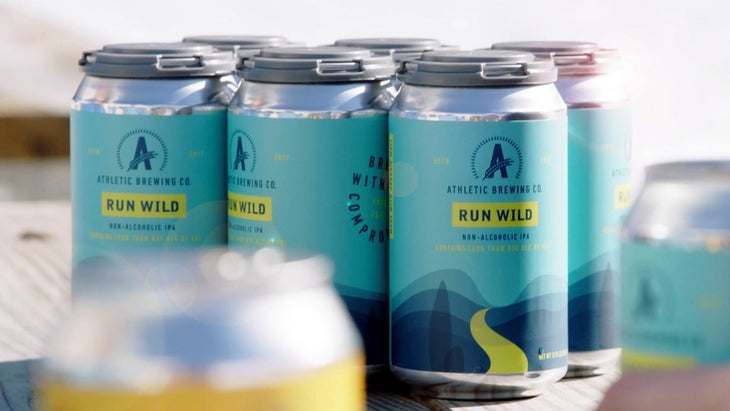New perk! Get after it with local recommendations just for you. Discover nearby events, routes out your door, and hidden gems when you sign up for the Local Running Drop.
At the height of the pandemic, alcohol sales and consumption were skyrocketing—and while endurance athletes might not have been at the front of the line at the liquor store, they were not exempt from the overall trend. Research done in Sweden last June revealed 16% of elite athletes reported increased drinking during COVID-19. With races canceled, motivation ebbing, and the accountability of group sessions all but erased, many athletes (elite and amateur alike) found themselves pouring an extra drink or two—and then it became more of a habit than they’d probably like.
It’s no secret that alcohol is bad for your health: it’s a known carcinogen, wreaks havoc with your sleep, affects hydration, impairs recovery, and can have a significant impact on your mental health—none of which sounds appealing to the triathlete keen to PR or score that coveted Kona spot.
Given that it is so dichotomous to all we do as athletes, how do we balance that—and do we need to? We spoke to some experts, who explained why the pendulum might now be swinging back in the opposite direction towards non-alcoholic drinks and sobriety.
RELATED: How Much Alcohol Consumption is OK for Your Health?
All or Nothing
Jeff Troesch is a sports psychologist and mental coach with more than 30 years of experience with both pro and amateur athletes across a wide range of sports. When it comes to endurance athletes, he said they have a propensity to “live life at the extremes” which can sometimes be problematic when it comes to alcohol consumption.
“Undoubtedly, I have seen athletes who live life at the extremes have a difficult time with moderation in just about anything,” he said. “For many, ‘go big or go home’ applies—whether it’s a training session, a night at the bar, or a weekend at the casino. Some high-level triathletes have a very black and white look at the world, and things are either OK or not OK, whereby the ‘OK’ things can be taken to extremes.”
Troesch said that while it might seem counterintuitive for those wanting to be fit for triathlon to also drink excessively, it happens with these extreme personalities.
He added: “Initially, some use alcohol for a number of socially acceptable reasons, and then they have difficulty recognizing or stopping the advancing effects of addiction or binge behavior. It could be argued that what it takes to train and compete in an Ironman is akin to binge behavior. Of course, I’m not implying that it is necessarily unhealthy, but it does mean that some people do extreme sports for unhealthy reasons and can find themselves having a difficult time backing down from the behavior, even after it’s been identified as unhealthy. Such may be true for some in their relationship with alcohol as well.”
This resonates with Ironman champion and Kona 2019 runner-up Ben Hoffman, who has now given up alcohol entirely and is sponsored by non-alcoholic beer brand Athletic Brewing. He identifies with what Troesch highlighted. “For me, and probably for a lot of athletes, we do live a life of extremes, and probably I lack the same internal governor that others may possess, including when it comes to drinking sometimes.
“Not that I drink a lot regularly, but there were times that when I did, it was too much. And of course, any time that you drink too much, it’s usually a lost day after. The evidence about the deleterious effects of alcohol are quite clear, and virtually all of the ‘one-glass-of-wine-a-day-is-healthy’ studies have been debunked. My job is to be a professional athlete right now, and the two aren’t very compatible.”
RELATED: A Nutritionist Shares What a Month of No Alcohol Did to His Body
Work Hard, Play Hard
Sarah Hays Coomer, a Mayo Clinic and National Board Certified Health and Wellness Coach, sees some endurance athletes she works with struggle with the “work hard, play hard” mentality.
“Athletes know unequivocally that their bodies are capable of extraordinary things. They routinely push themselves to the limits and bounce back,” she said. That can lead them to think their bodies will easily bounce back from a night (or two) of excessive drinking. “Also, endurance training requires an extraordinary amount of drive and focus. It’s inevitable that people need to blow off steam, and, for many, drinking is a socially acceptable outlet.”
Instead, she believes everyone needs to find the right coping mechanism for them, which wasn’t easy during a global pandemic—hence the rise in alcohol sales and consumption. The question to ask yourself is: Is your coping mechanism healthy? Is it liberating you or holding you back?
She said: “Most people can answer that question pretty clearly in the light of day, but it’s harder to make that call when you’re wrung out from crushing your training goals. Of course, if someone has a problem with addiction—blacking out, chronic hangovers, avoiding other activities in favor of drinking—they should seek medical help, but if people are just in an unhelpful habit loop, there are all kinds of ways to facilitate healthier choices.”
RELATED: How to Build Healthy Habits

Making Healthier Choices
When it comes to finding and making healthier choices, what you’re really doing is looking to change a habit, something that doesn’t just happen overnight. “The key to any habit change is to make sure your needs are being met,” Hays Coomer said. “What is alcohol doing for you? Is it a celebration? A way of shutting off your brain? A social lubricant? A gateway to relax at the end of the day? Once you know what you’re craving, you can explore other ways to fill that need. It takes some trial and error, but there are countless ways to infuse downtime with pleasure that don’t have anything to do with alcohol.”
She advises identifying when and how your habit happens, without judgment, and then looking for patterns in what triggers those habits. “Watch it as an observer for a few days and you’ll find patterns you can play with,” she said. “If you tend to drink heavily after a race (or after dinner), you will know in advance that the trigger for your habit is coming. When it does, try using something I call a “gap ritual,” a physical cue to pause and make space for a conscious decision about how to proceed: touch a specific object, do a few push-ups, make a gesture, take a breath, or eat a piece of ice. Then you’ll be able to avoid auto-pilot and make the decision on purpose: You can choose to have the drink like always or pick from your list of alternate reinforcements.”
(For more on how to build new habits and identify habit loops, check out our collection of guides on healthy habits.)
And when it comes to those alternate reinforcements, the options are now as varied as we are. For Hoffman, cracking open a non-alcoholic beer helped immensely. He said: “I find that when I have a non-alcoholic beer, it satisfies any desire I have and is refreshing without any negative side effects.”
And once you’ve broken that habit loop, you really start to feel the benefits of the change, which helps reinforce the new behavior. Hoffman said he feels the benefits to be as much mental as they are physical. “Generally, I have a more positive outlook across the board, living with more optimism and joy. I feel far more energized and better recovered from my training, I make better food choices, I sleep way better, my relationship with [my wife] Kelsey is more fulfilling and balanced, and I am considerably more productive in my ventures outside training and racing too.”
He believes there will be a continued rise in non-alcoholic beverages and sobriety, in part because of the boom in mindful living and in part because of a wider range of actually good options now. The stats back him up: non-alcoholic and low-alcoholic sales have been on the rise. While alcohol consumption went up, especially in the first half of the pandemic, non-alcoholic beer sales rose in the second half of 2020 by 44% in the U.S. That rise has been partially noticeable among the younger crowd.
“Perhaps it is the boom in mindful living as we explore more authentic ways to connect, feel good, and experience things to the fullest,” said Hoffman.
Or maybe it’s a realization that they can achieve their goals—whether finishing their first triathlon or nailing a PR—better by toning it down. All things in moderation, said Troesch, is tried and true advice because it’s held up over the years.
“If an athlete finds themself questioning their alcohol consumption and/or is receiving feedback from others that their alcohol use might be an issue, I would encourage them to seek professional input about whether or not there is an issue to be addressed,” he noted.
If you’re having an issue, check out the National Institute on Alcohol Abuse and Alcoholism’s useful resources.
